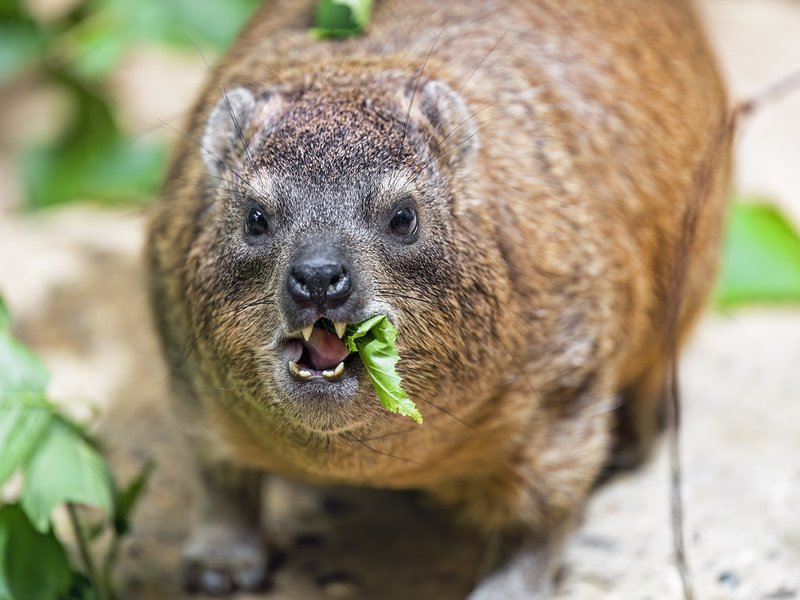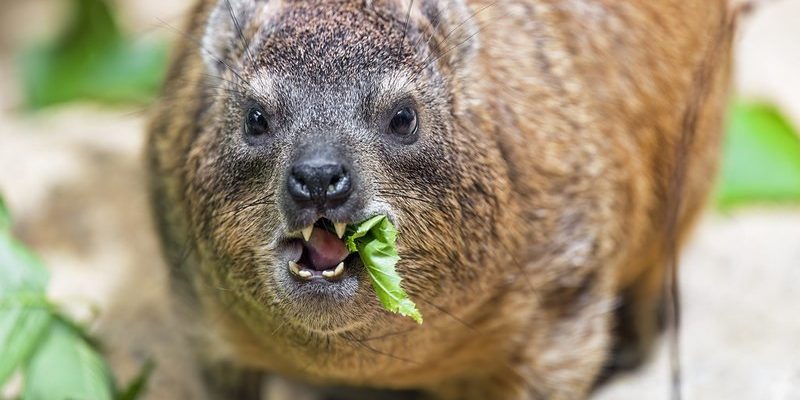
So, what do rock hyraxes eat, and how do they hunt or forage for food? Honestly, their approach is quite remarkable. Unlike other animals, they aren’t just snatch-and-grab type of eaters; they have a strategy that’s more about patience and precision. Let me explain how they navigate their rocky homes and what fuels their daily lives.
What Do Rock Hyraxes Eat?
Let’s start with the basics: what’s on the menu for rock hyraxes? These little guys are herbivores, meaning they primarily munch on plants. Think of them as the lawnmowers of their rocky habitats, keeping the vegetation in check. They enjoy a variety of food sources, which include:
- Leaves
- Fruits
- Flowers
- Grasses
Rock hyraxes have a particular fondness for the leaves of shrubs and trees. Their strong teeth and jaws are excellent for tearing apart tough foliage. But here’s the interesting part: they don’t just eat everything in sight. They’re quite selective, preferring certain plants over others based on the season and availability.
Another fascinating aspect of their diet is the way they process food. Hyraxes have a unique digestive system that helps them extract as many nutrients from their plant-based diet as possible. They rely on a fermentation process that’s similar to what cows do. This means they often need to eat a lot of food to get enough energy, which leads them to spend considerable time foraging.
Foraging Techniques of Rock Hyraxes
Now that we know what they eat, let’s dive into how they find their food. Rock hyraxes are masters of foraging. During the day, they can be seen climbing around their rocky homes, expertly balancing on cliffs and ledges. Here’s how their foraging strategies come into play:
1. Climbing Skills: Rock hyraxes are built for the high life. Their short limbs and clawed feet allow them to navigate steep rocky surfaces with ease. This skill is crucial when reaching for those hard-to-get leaves and fruits that high shrubs offer.
2. Social Foraging: Ever notice how some animals hunt or forage alone while others stick together? Rock hyraxes are social creatures that often forage in groups. This not only helps them stay safe from predators but also allows them to cover more ground and find food more efficiently. When one hyrax spots a tasty snack, the others follow suit.
3. Timing Matters: These little foragers are also smart about when they search for food. Most of their eating occurs during the cooler parts of the day, often morning and late afternoon. When the sun is high, you’ll find them lounging about instead of hunting, conserving their energy for when it counts.
Predators and the Role of Defense
With all this foraging, you might be wondering about the risks involved. Like many animals, rock hyraxes face threats from predators. They’re not top of the food chain by any means! They have to be cautious and smart about their interactions with the environment.
Some common predators include:
- Eagles
- Leopards
- Snakes
Their primary defense strategy isn’t to fight back; it’s to stay alert and use their surroundings wisely. Rock hyraxes are known for their sharp eyesight and keen hearing. They often use high lookouts to keep an eye out for danger. When one hyrax spots trouble, they have a special call to alert the others. This can be a quick whistle or squeak, sending everyone scurrying to safety among the rocks.
Hydration Strategies for Rock Hyraxes
While the focus so far has been on diet and foraging, let’s not forget about hydration. Finding water can be a challenge in their often arid habitats, but rock hyraxes have adapted well. They primarily get their moisture from the plants they eat. However, when the heat is on, they might also drink from small pools or dew in the early mornings.
Here’s the thing: It’s crucial for these animals to stay hydrated, especially in the hotter months. They often time their foraging not just for food but also to ensure they’re getting enough water from their plant choices. You might be surprised at how critical hydration is for their survival.
The Importance of a Balanced Diet
You might be wondering, why does all this matter? Well, a balanced diet is crucial for any animal’s health, and the rock hyrax is no exception. Their well-rounded approach to foraging helps keep their bodies strong and ready for whatever life throws at them.
They need a variety of nutrients to support their active lifestyle. A diet lacking in vital nutrients can lead to a host of health issues. With their social foraging habits, they instinctively understand the importance of variety, ensuring they aren’t missing out on essential vitamins and minerals.
In essence, the rock hyrax exemplifies the idea that a well-fed animal is a healthy animal. This balance keeps them agile on the rocks and alert to potential threats.
Rock Hyraxes in Their Ecosystem
Let’s take a step back and look at the bigger picture. Rock hyraxes aren’t just cute little furballs—they play a significant role in their ecosystems. Their foraging helps manage plant growth, and their activities can help recycle nutrients back into the soil. This, in turn, makes way for new plant life.
By keeping certain plants in check, they create a healthier habitat that benefits other wildlife as well. Healthy biodiversity is essential, and every species plays its part. This interconnectedness in nature is not just fascinating; it’s crucial for the survival of many species, including the rock hyrax.
So there you have it! The diet and hunting strategies of rock hyraxes are a testament to nature’s creativity and adaptability. From their selective foraging and social structures to their remarkable climbing skills, these animals have honed a survival strategy well-suited to their rocky environments.
Whether you’re admiring them from a distance on a hike or studying their habits, understanding their diet and hunting strategies provides a glimpse into the delicate balance of their ecosystem. Next time you spot a rock hyrax basking on a sunny rock, remember that there’s a lot more going on in their little world than meets the eye!

